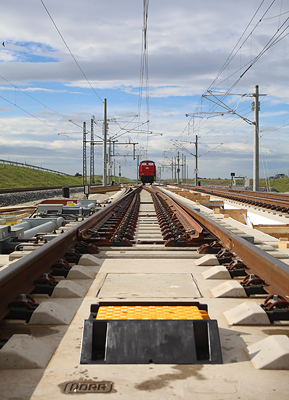First German long-distance line without fixed signals commences operation

The VDE8 construction project is divided into a number of project sections (VDE 8.1 to VDE 8.3): the new and upgraded route through the Thuringian Forest between Nuremberg and Erfurt (VDE 8.1) cuts the journey time between the major towns in the South and East dramatically - by up to 1 hour, 40 minutes. The new section between Erfurt–Leipzig/Halle (VDE 8.2) will mean improved speeds in the East-West direction. For example, the journey between Dresden and Frankfurt will be up to half an hour faster. The journey time between Leipzig/Halle and Berlin has already halved since 2006, when the upgraded route (VDE 8.3) became operational, and is now approximately one hour.
As part of the 8th German Unity Transport Project (VDE 8), Siemens and its consortium partner Kapsch CarrierCom Deutschland GmbH are currently equipping the new section from Ebensfeld via Erfurt to Halle/Leipzig with railway control, signaling and GSM-R technology.
Passenger operation has now commenced on the first stage from Erfurt to Halle/Leipzig. As a world first, conventional fixed signals are no longer being used. Communication between the vehicle and the line is transmitted via the GSM-R digital Global System for Mobile Communications – Rail. This permits speeds of up to 300 km/h and enables trains to travel at shorter intervals, thus increasing the throughput.
The new construction and expansion is necessary in order to be able to handle continuously increasing traffic volume, and to provide a competitive and environmentally friendly alternative to road and air travel. Siemens has equipped the entire 123 kilometer-long new section with the European Train Control System (ETCS) Level 2.
Its outstanding feature is constant communication between the vehicle and the line. With this system, train drivers no longer receive their commands – such as speed restrictions – via signals, but from a radio block center using the GSM-R digital railway radio system.
The on-board computer determines the position and direction of the train, and regularly transmits this information to the radio block center via GSM-R. The improvement over conventional train control systems is that the train driver no longer needs to brake before each signal in order to pick up the new movement authorities for the next line section.
Benefits: ETCS Level 2 not only reduces infrastructure costs to a significant extent, it also enhances line capacity thanks to anticipation and increases the permissible speed, thus reducing journey times.
The VDE8 rail transport project includes the new construction and extension of sections with an overall length of approximately 500 kilometers between Nuremberg, Erfurt, Halle, Leipzig and Berlin. Once completed in 2017, the journey time between Munich and Berlin will be reduced to less than four hours.
The construction project is divided into a number of sub-projects (VDE 8.1 to VDE 8.3): The new and upgraded Nuremberg-Erfurt route through the Thuringian Forest (VDE 8.1) cuts the journey time between cities in the South and East dramatically – by up to 1 hour and 40 minutes.
The high-speed line between Erfurt–Leipzig/Halle (VDE 8.2) will mean improved speeds in the East-West direction. For example, the journey between Dresden and Frankfurt will be up to half an hour faster. Travel time between Leipzig/Halle and Berlin has already halved since 2006 when the upgraded route (VDE 8.3) became operational, and is now approximately one hour.
This press release and a press photo are available at www.siemens.com/press/vde8
Siemens AG (Berlin and Munich) is a global technology powerhouse that has stood for engineering excellence, innovation, quality, reliability and internationality for more than 165 years. The company is active in more than 200 countries, focusing on the areas of electrification, automation and digitalization. One of the world's largest producers of energy-efficient, resource-saving technologies, Siemens is No. 1 in offshore wind turbine construction, a leading supplier of gas and steam turbines for power generation, a major provider of power transmission solutions and a pioneer in infrastructure solutions as well as automation, drive and software solutions for industry. The company is also a leading provider of medical imaging equipment – such as computed tomography and magnetic resonance imaging systems – and a leader in laboratory diagnostics as well as clinical IT. In fiscal 2015, which ended on September 30, 2015, Siemens generated revenue of €75.6 billion and net income of €7.4 billion. At the end of September 2015, the company had around 348,000 employees worldwide.
Further information is available on the Internet at www.siemens.com
Reference Number: PR2015120110MOEN
Contact
Ms. Katharina Zoefeld
Mobility Division
Siemens AG
Otto-Hahn-Ring 6
81739 Munich
Germany
Tel: +49 (89) 636-636802
Katharina.zoefeld@siemens.com
Media Contact
All latest news from the category: Transportation and Logistics
This field deals with all spatial and time-related activities involved in bridging the gap between goods and people, including their restructuring. This begins with the supplier and follows each stage of the operational value chain to product delivery and concludes with product disposal and recycling.
innovations-report provides informative reports and articles on such topics as traffic telematics, toll collection, traffic management systems, route planning, high-speed rail (Transrapid), traffic infrastructures, air safety, transport technologies, transport logistics, production logistics and mobility.
Newest articles

Properties of new materials for microchips
… can now be measured well. Reseachers of Delft University of Technology demonstrated measuring performance properties of ultrathin silicon membranes. Making ever smaller and more powerful chips requires new ultrathin…

Floating solar’s potential
… to support sustainable development by addressing climate, water, and energy goals holistically. A new study published this week in Nature Energy raises the potential for floating solar photovoltaics (FPV)…

Skyrmions move at record speeds
… a step towards the computing of the future. An international research team led by scientists from the CNRS1 has discovered that the magnetic nanobubbles2 known as skyrmions can be…





















